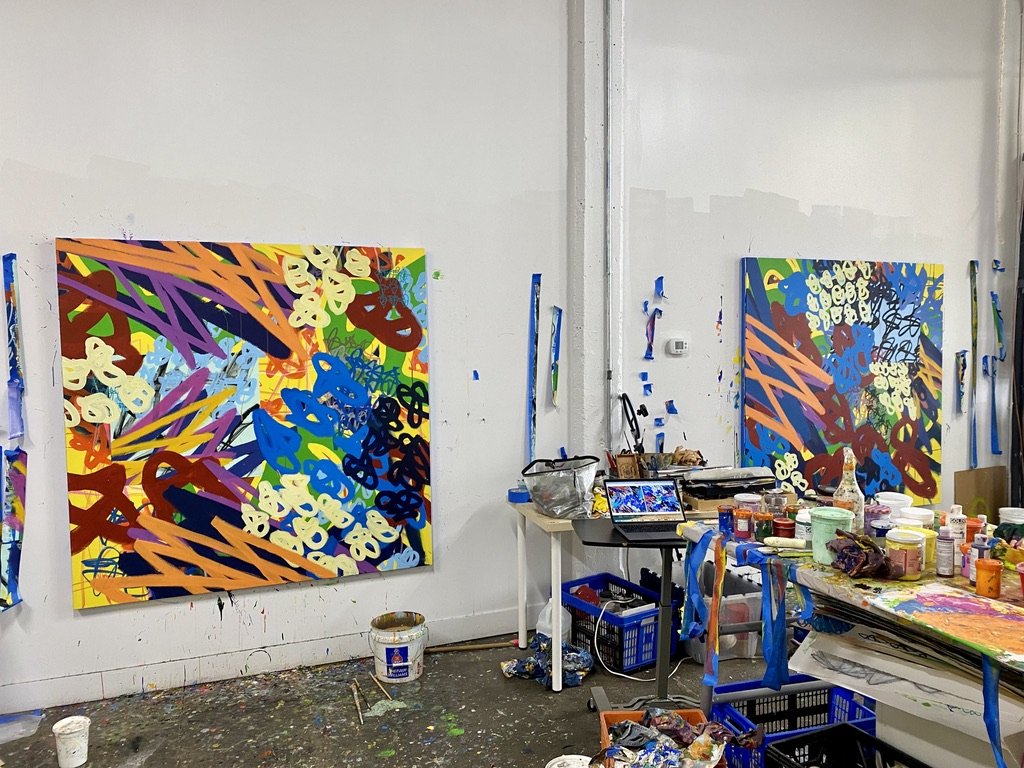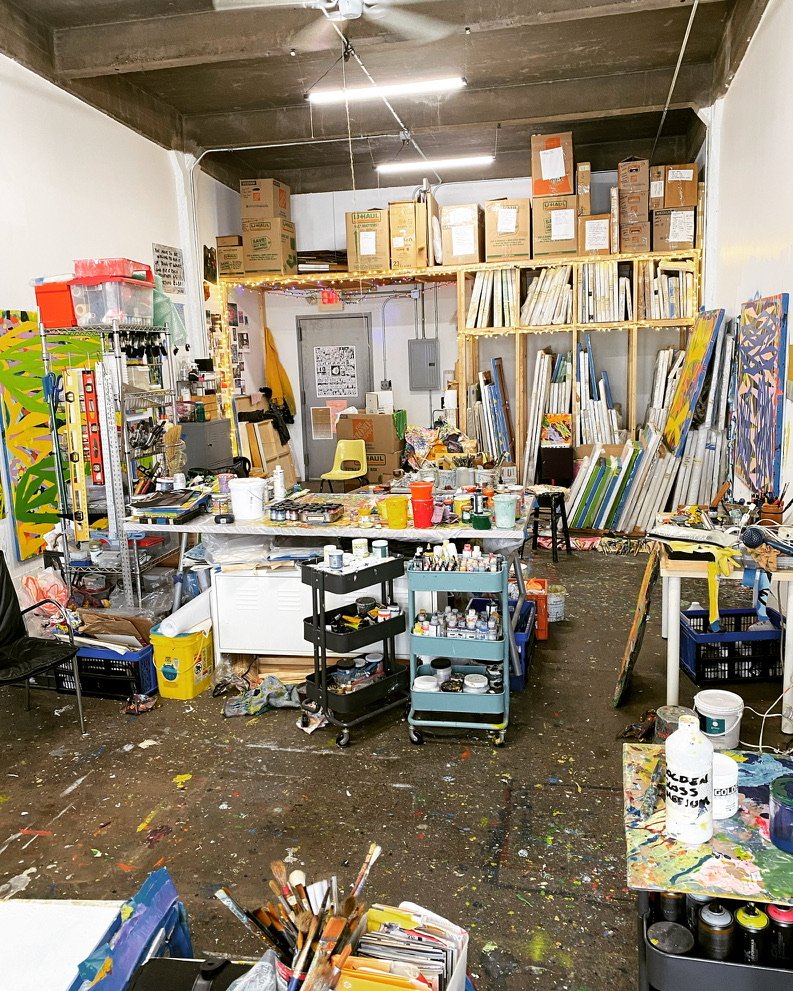Tim McFarlane
Philadelphia, Pennsylvania
Website
timmcfarlane.com
Social Media
Instagram
How would you describe your work?
The short answer is that I make abstract paintings that reflect a lived existence. I’m drawn to the residue of everyday life that I witness from living in a city: the interventions by people on the built environment through graffiti, posters, discarded clothing, the intersection of different materials used for purposes of repair or construction. Moving through spaces where micro and macro changes take place, sometimes without us noticing. The letter-like forms in a lot of my work from the past 8 years are called “glyphs”, which reference communication and energy that people bring to various built spaces. My more recent works are of an even more abstract nature, but maintaining the layering of structures as before.
Besides painting, I’m also involved in photography as a way of documenting what I see. Photos also act as reference points for clues that I can use to solve problems in a painting that’s not working. Murals, printmaking, and drawing- based installations all figure into my practice, as well.
What inspires you?
Life, nature, music, readings, other art, traveling. There are a lot of people I could say that I’m inspired by, but honestly, it’s more about being affected by the attitude of curiosity, continual discovery and how that shows up in how people navigate whatever it is that they do. Art, whether visual, writing, filmmaking, etc..., inspires me often to push beyond what I think I already know. The process of making art is inspirational enough in its own right. I’m generally more interested in the discoveries made during the journey to a resolution than I am in the final work.
Can you speak about your process?
My process is built on a combination of planning and chance happenings. I never know exactly what I’m going to paint, there’s no predetermined endpoint or anything. I have a general idea of where I want to start in terms of forms and colors. I never know how they will resolve themselves in the work. I don’t make sketches that carry through to become paintings. To build up my images, I rely on a lot of “call and response”, seeing what happens on the surface as I add and subtract elements. Every move gets integrated into the artwork in some way. “Accidents” integrated or removed if they don’t work. Every start of a new painting is somewhat fast and over time, there’s a bit more looking and thinking going on between adjustments in the work. By the time a painting is maybe 75% complete, I like to joke that my process becomes more akin to watching grass grow the closer I come to a resolution because I’m usually doing more thinking than doing at that point.
I tend to work on several pieces at once. Working this way allows me some latitude in the painting process to experiment, as well as to aid in solving problems that may come up in a particular painting. I may set that piece aside, work on something else and return to the first painting with a fresh eye and possible solution from working on a second or third painting.
How did you become interested in art?
I’d been interested in making art as a child, ever since I made a cardboard cutout of a human figure out of one of my mother’s shoeboxes around the age of 6 or 7. That was the first thing I made that felt like it was wholly mine. From there, I always liked my art classes more than other subjects. Drawing from coming books was a big thing for me growing up, but it wasn’t until 11th grade that I began considering making art my lifelong work. In high school, I was exposed to Old Master works (Caravaggio, Rembrandt, DaVinci, etc...) and Impressionist and Post-Impressionist works in learning how to draw from observation and use color. This combined with museum and gallery-going helped to open my eyes to the possibilities of art. Because of studying Impressionism, I began doing still life and plein-air landscape painting in high school. It wasn’t until I was in college that I moved to making more abstract works.
Do you have any favorite artists, movies, books or quotes?
I have favorite artists that span a range of eras, like the afore-mentioned Caravaggio, Chardin, Manet, Monet, Cezanne, Matisse, Franz Kline, Joan Mitchell, Richard Diebenkorn, Sam Gilliam, Benny Andrews, Hilma af Klint, Richard Serra, Jack Whitten, Martin Puryear, Brice Marden, the list goes on.
Movies - lots of sci-fi and random movies from other genres like the original Taking of Pelham 123 (1974), The Graduate, Alien (1979), Aliens (1986), Pulp Fiction, the first Star Wars trilogy, the original Halloween, Arrival, Do The Right Thing, a lot of the Marvel films, lots of indie films during the 90s and 2000s...
Books: Like movies, I’ve read a lot of sci-fi and Octavia Butler is a favorite, I like the work of Neil Gaiman a lot through some of his books and The Sandman graphic novels, Sonia Sanchez for poetry, bell books and more. I also love comics/graphic novels because good stories and good visuals together have always drawn me in. I read a lot of art-related books, as well.
Quotes: I have two that I always fall back on:
“Inspiration is for amateurs. The rest of us just show up and get to work. Ifyou wait around for the clouds to part and a bolt of lightening to strike you in the brain, you are not going to make an awful lot of work. All the best ideas come out of the process; they come out of the work itself.” -Chuck Close
The second one is one I made up years ago. It’s a reminder to not let any piece or idea become too precious to change:
“Be willing to rip it up, tear it apart and make it into something else”
What advice do you have for younger artists?
If you’re in school, take full advantage of everything you have available: the knowledge of your professors (ask all of the questions), the resources at your disposal like space, equipment and time to devote to learning and making.
The work comes first. In our age of social media and everyone being extremely online, make the work that YOU want to see in the world and not just emulate what you see and think is popular online. The number of ‘likes’ and followers have nothing to do with the worth nor integrity of your art. As an artist, the main thing that you need to keep in mind is that the work you make is for you first; it’s for your learning, joy and what you want to see in the world.
As artists, we have to be resourceful, but even then, there are limits to what we can learn and there’s only so much time. Build a community of people around you who do different things than you do so that you might be able to help each other with aspects of your projects that you can’t do alone.
A lot has been done in the world, but it’s not “all been done before”, at least not by you. We don’t make anything nor come up with an idea in a vacuum, everything about our experiences influence what we make, including other artwork that we interact with. Embrace learning from other artists who came before you, learn the “rules” and break them to make room for what is authentically yours in the work.
Any more thoughts about art, creativity, or anything else you would like to share?
“Art is not a luxury” is a quote from a bumper sticker I had a long time ago. I also had it as the signature at the foot of an old email account for many years and someone once asked me what it meant. I explained that art is a necessity, not a luxury. We’ve come so far from a time when art was embedded into everyday life mostly due to necessity; we had to make a lot of the things we needed to survive like clothing, shelter and tools. Creativity was built into that process because of problem solving needed for everyday survival, as well as to find better ways of making tools and such work better for our evolving needs.
A very large segment of people and media outlets view art only through the lens of the financial market. For those people, art is a good/property with an assigned value that they can choose to trade for money at auction. At this level, art making has been boxed into the arena of specialty goods and deemed a “luxury”. As such, the stories around art in the U.S. focuses more on its monetary value more than any other aspect. The capitalist framework of our society funnels almost everything, including art, through a financial lens that limits the perception of its intrinsic worth.
Of course, art is way more than that and functions in a myriad of ways for everyone; for self expression, storytelling, a method of revealing things about life in ways previously unknown. It goes without saying that art is a necessity for helping us navigate life in so many ways. It’s through painting, sculpture, writing, dancing, poetry, plays, movies and more that we connect with life and each other in ways that go beyond financial concerns. So, no, art is not a luxury, but woven into the very essence of what it means to be human.
























